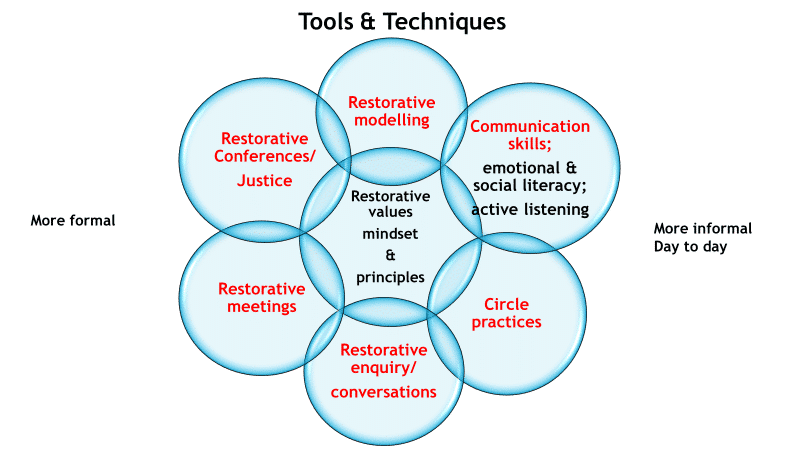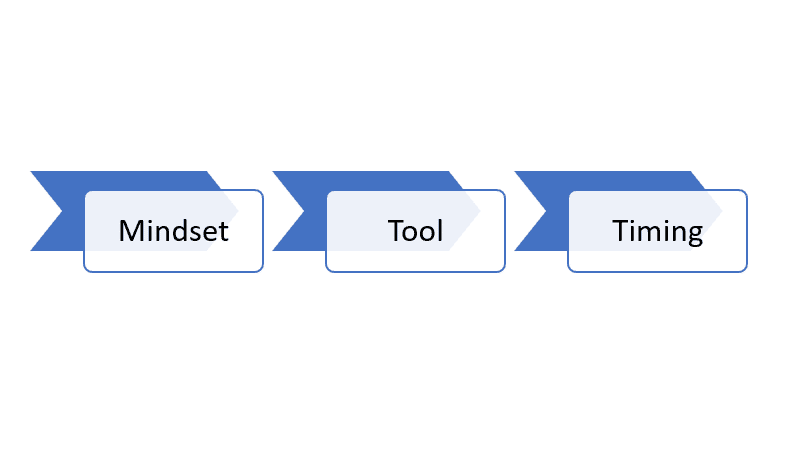Due to the fact that restorative approaches are a collection of tools and techniques all hailing from the same mindset and value base, it means that there in fact many many tools that can be drawn upon. Most modern training stems from the restorative mindset of relationships, relationships, relationships. Whether with yourself or another person. This is means that if you learn new skills from training such as Motivation Interviewing or PERMA, they will slot immediately into your restorative toolkit.
However, there are traditionally core restorative tools and techniques as well. In the image below we can see the most commonly used restorative skills.

At the heart of every restorative tool is a restorative mindset and core restorative principles. We realise that may seem obvious, but let us break it down.
We have already mentioned restorative justice meetings in the previous topic. The represent the more formal end of the restorative toolkit. Imagine if a person was to facilitate one of those meetings between two people who had fallen out, but they had an un-restorative mindset.
This might sound something like this
“This is such as waste of time”
“They just need to agree to disagree and get on with it”
“We’re all adults here, you’re not going to like everyone”
“Clearly one person is in the right, and I need to make that clear in this meeting”
“If someone is to blame, then they should have a disciplinary, not sit and chat about it”
A facilitator with this mindset would struggle to uphold the restorative principles (which will be covered in the next topic). If the person facilitating a meeting does not uphold and encourage the restorative principles then those involved are more likely to not fin a way forward and further harm may be caused.
So in essence, the restorative toolkit is only as good as the person wielding it. That is not always the easiest pill to swallow. How many of us have blamed a tool for not working, when it was more down to our own skill level?
In addition to this, not every tool is right for the job. And not every job requires that tool at that point!
What do we mean?

One thing that we have heard on occasion very exasperated professionals is “This restorative stuff doesn’t work”.
Watch this video to unpick what’s going on here.
- What is restorative stuff?
- One misconception about restorative work is that it is only a tool kit. And a limited toolkit of circles, restorative questions and restorative meeting. The person has tried one of these tools once or twice, with a very challenging person and it didn’t work. Therefore none of it works. They misunderstand
- Emotions of those involved
- Mindset of professional
- Mindset of other
- Choice of tool
- Iv’e tried everything
- Timing – may never be the right time
Common Toolkit:
Modelling: Picture of “if you’re not modelling what you teach”. In any relationship whether in the workplace or at home, hypocrisy is one of the most damaging things. “do as I say not as I do”. Being called out for something that someone did only last week. Emotions flare and we struggle to maintain healthy bonds with that person. We can also be guilty of having higher expectations of others than of ourselves. This is particularly true of children. We often expect better behaviour from 5 year olds than adults. Do you recall being at school and a child walked in late, only to be reprimanded by the teacher in front of the class. Do you think that they publicly reprimanded other adults in that way?
One of our favourite quotes to remind us to model restorative values is
“You can’t talk your way out of something you’ve spent years behaving your way in to”.
Actions speak a lot louder than words.
Communication: There are a vast amount of different skills that can be included in the restorative communication toolkit. Some of the greatest hits include active listening, affective statements and I messages. Restorative communication is designed to keep the channels open, to be heard and to be able to challenge others as well
Circles: A fundamental tool in every restorative practitioner’s kit. Whether it’s running team meetings using circle practice, family meetings, lessons or multi-disciplinary meetings, all can be improved using circle practice principles. This will be covered in the next lesson.
Enquiry: The restorative questions that practitioners use when discussing an issue. Generally they are used when things have gone wrong, but they can be equally used when things have gone right as well. The questions can provide a loose framework for a conversation all the way up a formal script for conferencing.
Meetings: Restorative meetings can be formal or informal but generally require less preparation and represent lower risk issues than conferencing. They use the restorative enquiry to guide the conversation and formal meetings will have records kept.
Conferencing: Reserved for high end cases where there is risk of further harm by being in the meeting. The also often involve multiple services and can involve multiple harmed people or people that have caused harm. They require extensive preparation and follow up work.
All of the tools listed can be completed as training through WRAP’s e-learning system, except restorative conference training. This must be completed via live training. Please contact the team for further information.



